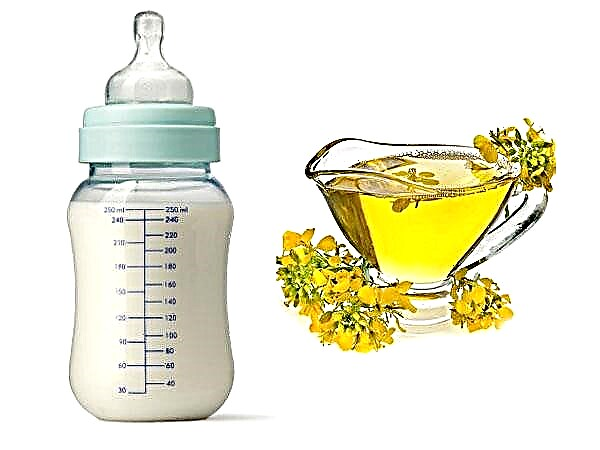
Dairy-free porridge often appears in the diet of infants immediately after vegetable feeding. This product meets the energy needs of children and helps to gain weight. If the crumb adds weight well, then with the help of cereals you can diversify the menu of the toddler, gradually introducing him to new tastes.

Composition and benefits
Any porridge is rich in complex carbohydrates, plant proteins, dietary fiber, vitamins and other useful substances that are used to grow and support the health of babies.
Compared to milk porridge, porridge without added milk is less allergenic, because it lacks protein molecules from cow's milk, to which babies can react with a rash, tummy pains and other negative symptoms.
Depending on the type of cereal, dairy-free porridges have the following features:
- Rice contains a lot of calcium, amino acids, zinc, lecithin, phosphorus, vitamins B, iodine. One of the main benefits of rice is the absence of gluten, a protein compound that some people have a negative reaction to. Porridge made from such cereals rarely causes allergies, is easy to digest, tastes good.
- Buckwheat is rich in proteins and iron, so it should definitely be on the menu of low-birth-weight babies and crumbs with anemia. This is also gluten-free cereal, so the risk of an allergic reaction to buckwheat is very low. From such a dish, the child will receive zinc, calcium, methionine, copper, lysine, magnesium, vitamins PP, B1 and E.
- Corn grits is another gluten-free cereal. It contains a lot of dietary fiber, amino acids, calcium, vitamin A, iron and other substances. Porridge made from this cereal helps to reduce fermentation and bloating, and also has a positive effect on the nervous system thanks to polyunsaturated fats.
- Millet also does not contain gluten, but it is harder to digest than rice and buckwheat porridge, so it is not recommended for babies under one year old.
- Oatmeal gives the child plant proteins, B vitamins, various minerals (zinc, iron, magnesium, manganese and others). It is also rich in unsaturated fat and is a source of fiber.
- Barley grits acts as a source of amino acids, choline, potassium, vitamin A, calcium, selenium, vitamin K and other substances. It is nutritious, good for digestion and immunity, and prevents constipation.
- Semolina rich in starch and proteins, but inferior to other cereal products in terms of vitamin and mineral composition and dietary fiber content.
- Pearl barley contains many vitamins B2, PP and B1. It is especially rich in fiber and starch, as well as calcium, copper and phosphorus.

When do they start giving?
To determine whether a child is ready to try porridge, it is best to contact a pediatrician, because the beginning of such feeding depends not only on the type of feeding the baby, but also on the state of his health. For example, if the baby is not gaining weight well or he has problems with stool, it is more advisable to introduce into his diet as the first complementary foods not vegetables, namely cereals without adding milk.
When breastfeeding
Age recommended by most doctors for the introduction of dairy-free porridge in the baby's menu - 6 months. If the baby receives enough mother's milk, there is no need to introduce such a product into the diet earlier. Moreover, the baby's digestive tract must mature enough for normal digestion of cereal dishes.
If the complementary feeding began with vegetables, then the porridge is allowed to taste about a month after that, that is, at the age of 7 months.
The portion for the first sample should be no more than 10 grams. It is recommended to give it to a child in the morning. Having offered the baby a spoonful of a new product, the mother should carefully monitor its tolerance, because individual hypersensitivity happens even to hypoallergenic dishes.
If the child does not have a rash and other negative reactions, then the next day you can offer the little one a larger portion. So gradually it is brought to the norms recommended for the baby's age:
- at 6 months - 150 grams;
- at 7-8 months - 150-180 grams;
- from 9 months - 200 grams.

With artificial feeding
If the child is bottle-fed, it is allowed to introduce him to porridge a little earlier.
Although on packs of ready-made cereals you can see the mark "from 4 months", but most pediatricians consider the optimal age for feeding cereals for artificial children is 5 months.
You need to start giving porridge as carefully as a breastfed baby, assessing the tolerance and gradually increasing the daily portion:
- at 5 months of age the volume of porridge at one time can be increased to 150 grams;
- at 6 months - up to 150-180 grams;
- from 7 months - give the child 180-200 grams of such a dish.

Choosing cereals
As for the varieties of cereals, depending on cereals, their inclusion in the diet of babies takes place in several stages:
- The first child should try rice and buckwheat, as these are gluten-free cereals and are easy to digest. With a tendency to constipation, buckwheat porridge is preferred.
- Later, the baby is offered a third gluten-free porridge - corn. Since it is absorbed a little worse and is not so rich in calcium and phosphorus, on an ongoing basis, corn cereal porridge is included in the children's menu from 9-10 months.
- Acquaintance with cereals containing gluten is recommended not earlier than 8 months. If the crumbs have a tendency to allergies, then such complementary foods are advised to be postponed for up to 1 year.
- Barley is introduced into the diet of children from 1.5-2 years old, and barley porridge is offered to children over three years old. Such a late inclusion in the diet is due to the severity of digestion of barley, from which these cereals are made.
Each new porridge should be introduced into the menu some time after acquaintance with the previous one. Usually it is 7-10 days so that a negative reaction, if a baby has it for a new dish, has time to manifest itself.
Once the baby is used to two different one-component cereals, he can be offered a mixture of such cereals, for example, rice-corn porridge.


All dairy-free cereals can be divided into two large groups:
- factory;
- cooked at home.
Factory
Cereal mixtures produced for babies by baby food manufacturers, are hypoallergenic and expanding the menu. The former usually contain only crushed raw materials from one gluten-free cereal, and the latter can be multicomponent, often including fruits and other additives.
Factory porridge is sold in boxes or cans, which have detailed instructions on how to dilute or cook a specific product. The recommendations of different manufacturers differ, so after buying a new porridge, you must first carefully read all the information on the label. The difference often lies in the proportions of the liquid and its temperature.


Shop cereals have many advantages, so they are in demand among young parents.
The raw materials for them are carefully controlled and tested for safety. Products are crushed according to the age category for which they are intended.
Another feature of factory cereals is their enrichment with valuable substances in the manufacturing process. First of all, we are talking about vitamins, which are added to the cereal mixture, if they were initially few in it or they were destroyed due to the technological process.
Some cereals are enriched with prebiotics (oligofructose, inulin) and probiotics (bifidobacteria), so that such products improve digestion and stimulate the growth of beneficial intestinal flora.
Depending on the method of preparing porridge without milk, there are:
- powder mixtures that only need to be diluted with liquid;
- powders that need to be boiled for a short time;
- chopped cereals, which are pre-brewed and infused;
- ready-made cereals that the child can eat right out of the box or jar.

Rating of ready-made cereals by manufacturer
The assortment of cereals without milk added in supermarkets is now very extensive, so you can choose and buy a suitable option for such a complementary food for any baby. The most popular dairy-free cereals are presented in the review.
Remedia
Such cereals are considered high quality by pediatricians and are recommended for problems with stool, kidney disease and other pathologies. They are made without preservatives, include useful vitamin supplements, and are economically packaged.

Hipp
The advantage of such cereal products is an organic basis and environmental friendliness. All porridges of this brand undergo strict control, they have a wonderful taste and simple composition, but there are no vitamin and mineral compounds, in addition to vitamin B1, in such products.
In addition to dry cereals without additives, such a manufacturer offers buckwheat porridge with fruit and oatmeal with the addition of banana and lemon balm for better falling asleep.
In addition, the Hipp range includes ready-made cereals with fruit, packaged in jars and intended for afternoon tea.

Heinz
The porridges of this manufacturer are very diverse (there are many types with fruits), have a pleasant taste, are enriched with inulin and a vitamin-mineral complex. They do not contain salt, starch, sugar.
According to mothers, these cereals are easily diluted with water, forming a homogeneous dish without lumps.

Baby sitter
The composition of such dairy-free cereals includes a large list of vitamins and trace elements. They do not contain fruits, sugar, or any other fillers.
Since cereals undergo a special treatment, less dry product is spent per serving than other manufacturers.

Nestle
This famous brand offers various dairy-free cereals, which, thanks to the addition of bifidobacteria, normalize stool and stimulate the growth of microflora, are enriched with mineral and vitamin substances. Such cereal products are easily diluted with water, have a good smell and natural taste.
The quality of Nestlé cereals is high, the price range is average, but some of their types contain traces of milk, lactose and gluten.

Babushkino Lukoshko
In milk-free porridges of this brand, there is no starch, salt, sweeteners and other fillers. They do not form lumps when diluted, taste good, contain minerals, prebiotics, useful vitamins.

Bebi
Dairy-free cereal products from such a manufacturer have a natural taste, are varied, enriched with minerals and probiotics. There is no sugar in such cereals, but fruit juices and other fillers are often found.

Agusha
The line of dairy-free cereals from this manufacturer is quite wide. They contain vitamins, no preservatives or harmful additives. Such cereals are quickly divorced and well digested, have a pleasant aroma, and are tasty. Their disadvantages include only a small package size and a short shelf life.

Frutonyanya
Under this brand you can buy dairy-free rice, buckwheat, corn and multigrain porridge. They are inexpensive, dissolve quickly, have a pleasant taste, do not contain sugar, and are enriched with vitamin compounds, as well as inulin (except for buckwheat) and minerals.

Baby
Such a company produces buckwheat and corn porridge, as well as their mixture. Their composition is enriched with minerals and some vitamins, does not include sucrose.
The disadvantages of such cereals include a small assortment, frequent formation of lumps, the presence of maltodextrin.

Diy dairy-free porridge recipes
If the mother does not want to feed the baby with store porridge or does not want to spend the family budget on it, it is quite possible to cook dairy-free porridge at home. There are 2 ways to do this.
- Dry cereals are ground in a coffee grinder, getting flour, which is boiled after boiling with constant stirring until tender. For 5 g of such flour, take 50-100 ml of water, depending on the desired consistency. Breast milk or mixture is added to the cooled porridge.
- The groats are washed, poured with water in a ratio of 1 to 4, after which it is boiled over low heat until it is completely boiled down. Unlike the previous method, the cooled porridge is interrupted with a blender or rubbed through a sieve until a homogeneous mass is obtained, into which a little mixture or human milk is then added.
There is no need to add sugar and salt to dairy-free homemade cereals.
To diversify the dish, mom can cook porridge with vegetable or fruit broth, add vegetables, yolk, oil, fruits and other products after cooking that the baby has already gotten to know.

And a few more tips, if the child does not like dairy-free porridge.
- You should not refuse the introduction of a certain cereal if the baby does not like it. Offer the crumbs the same porridge, but from a different manufacturer, since the smells, textures and taste characteristics of products from different companies are slightly different.
- If you cook the porridge yourself, try changing the amount of liquid. Perhaps the baby will like a more diluted dish or, on the contrary, the baby will be happy to eat thicker porridge.
Watch the video in which you will learn about the intricacies of complementary feeding with dairy-free cereals.
Find out if your child's weight is normal using the following calculator.



